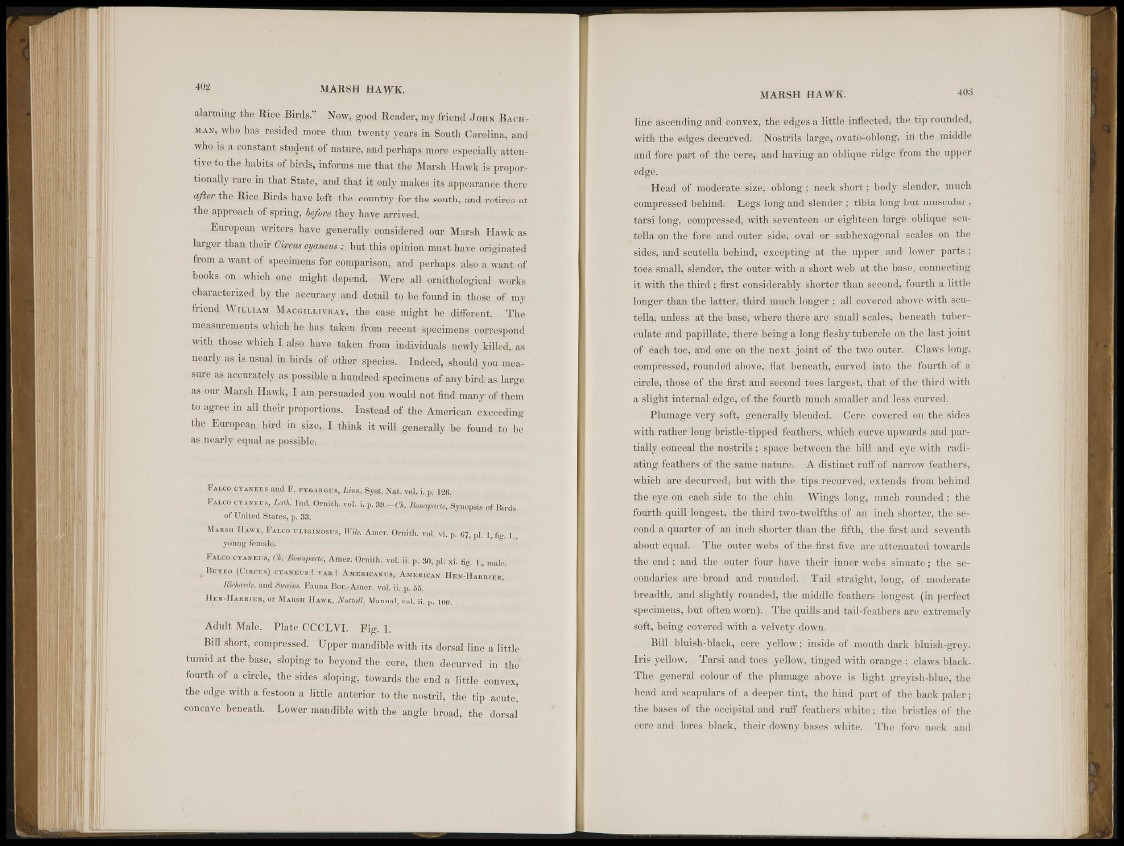
402 MARSH HAVKK.
al»jmng the Kico Birds-" Now,, good Reader, my friend Johk Bach
man, who has raided more than .twenty yeiH'S in South Carolina, and
w h o I«- a ''0'istant stnijoiit <>f nature. ami perhaps more eternally attentive
to the habits-of birds, inferos me that the Marsh Hawk is proportionally
rare in that State, and thai ifLonly makes its;,appearance. there
after \\w |i,i.eB Birds, have left ¡the. country for the ««nth, and retires at
the approach of spring; before they have arrived.
Kurupoim writers, liave. .generally «otisidcred our Marsh Hawk as
larger than their Vircm c-yanem but this opinion must have originated
from a want of spumous for. comparison; and perhaps a!«, a want, of
b o o k s uu »hi,;U,.one might depend... Were all ornithological, works
characterised by tile asejiraev and detail to he toutul in those ,uf my
friend U'im.iam Macgh.uvk.yy, this case might b,e dim-rout. . .The
nieasuromeiiu .whic.li he. has ta>cn fe<;m recent specimens. Kon-esponcl
with those nli'ch I, also have taken from individuals newly krlh-d.. a«
n e w l j a s is usual in birds of other sp««, . Indeed, should you-mea,
s u r " as.accurately as possible a hundred specimens of any birdias.largn
a s " u r M!U"»!l "a l v k > !: am persuaded you would, not find many of them
to agree in all their proportions, Instead of the .Ymerietui .exceeding
the European bird in size,. I, think it will generally be found to he
as newl y equal as pjiss-iWcii-.
EALCO qiansus B. p.YaABs.c^ fli^igjjji. Kst. voisi.p. 126,.
, I > l c o M1 ' - ^ Ornfiayj| i,j>. 39.,, O^/fa^tf*, SjuojiMs ulUird,,
of XTnited States., p. 33,
Maish Hawk, Paioo Amer Ormth vilTFp 67, pi l.fig'l""'
young female. : '
Kaii:« cvasrl's, vol. 3(1, pV »Sjj. 1., ,,,„!„. -,.
4 AMMgisjjs. A.mkhicax UJW-IIAII'MFI,.
; i'anna.Loi'.-jXiraer. ^ ¿ . ii. p. 55.
lis» IlABHif.«, or Harsh Hawk, XuluM, Manual, vol. ii,j', 109.
Adult Mail; Plate CCCLVI. >ig. ].
Bill short, «impressed. Upper mandibl fet h its dorsal line a little'
tumid at the base, sloping to beyond the core, then dceurved in the*
fourth of a circle, the sides sloping, towards the end a little W e i " "
the ©lie Willi k fustodn a little anterior t,. the nostril, the tip' acute!
•concave beneath. Lower mandible with the angle broad, the dorsal
MARSH HAWK. 403
line ascending anil convex, the edges' a little inflected!, the tip rounded,
With the edges dècurved. Nostrils large; ovatò-oblong, in the middle
arid fore part of Ilio'Cere,' lind having an oblique ridge from the upper
edge. '1
Head«)}' moderate ¿izc, oblong ; neck short ; liody slender, mùfch
compréàsed behind. l-.egs long and slender ; tibia long but muscular ;
tarsi long, compress«''!,«with seventeen or eighteen large oblique' scutBllffi
on the fore and. outer side; oviil or stibhexagonal scales 011 the
siéeè, and seutella behind,- excepting at the upper and lower parts ;
toes small, slender, the outer with ai short web at the baso, connecting
it with the third ;• first considerably shorter than second, fourth a little
longer than the latter, third much longer all covered above with seti •
teîla, unless ait the base, where there are small scales,- beneath, tubercolate
and papillate, there bei ng a long fleshy tubercle 011 the last joint
of* ëach- toe, am: one en the next joint of the two outer. Claws long,
compressed, rounded above,- ilat beneath, curved into the fourth of a
circle, those of the first and second toes largest,: that of the third with
a slight internal edge, of the fourth much smaller and loss curved.
Plumage very soft,- generally blended. Cere covered on the sides
with rather long bristle-tipped feathers, which curve upwards and partially
conceal the nostrils ;; space-between the bill and eye with radi
»fling, feathers òf the same nature: A distinct ruff of narrow feathers,
whi'eh are decurved, but with the tips recurved, extends from behind
the eye 6n each side to ¡the chin. Wings long, much rounded; the
fourth .quill longest, the.third two-twelfths of an inch shorter, the second
a; quarter of an inch shorter than the fifth, the first and seventh
about: equal. The outer webs of tin- first five are attenuated towards
the end ; and the outer four have their inner webs sinuate ; the secondaries
are broad and rounded. Tail straight, long, of moderate
breadth, and slightly rounded, the middle feathers longest (in perfect
specimens, but often worn). The quills and tail-feathers are extremely
soft, .being covered-with a velvety down.
Bill, bluish-black, cere yellow; inside of mouth dark bluish-grey.
Iris yellow. Tarsi and toes yellow, tinged with orange ; claws black.
The general colour of the plumage above is light greyish-blue, the
head and scapulars of a deeper tint, the hind part of the back paler ;
the bases of- the occipital and ruff feathers white ; the bristles of the
cere arid lores black, their downy bases white. The fore neck and